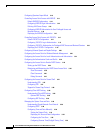
Contents
5
Cisco IOS Software Configuration Guide for Cisco Aironet Access Points
OL-29225-01
Defining HTTP Access 5-35
Configuring a System Name and Prompt 5-35
Default System Name and Prompt Configuration 5-35
Configuring a System Name 5-35
Understanding DNS 5-36
Default DNS Configuration 5-36
Setting Up DNS 5-37
Displaying the DNS Configuration 5-38
Creating a Banner 5-38
Default Banner Configuration 5-38
Configuring a Message-of-the-Day Login Banner 5-38
Configuring a Login Banner 5-40
Upgrading Autonomous Cisco Aironet Access Points to Lightweight Mode 5-40
Migrating to Japan W52 Domain 5-41
Verifying the Migration 5-43
Configuring Multiple VLAN and Rate Limiting for Point-to-Multipoint Bridging 5-43
CLI Command 5-44
CHAPTER
6 Configuring Radio Settings 6-1
Enabling the Radio Interface 6-2
Configuring the Role in Radio Network 6-2
Universal Workgroup Bridge Mode 6-5
Point-to-point and Multi Point bridging support for 802.11n platforms 6-5
Configuring Dual-Radio Fallback 6-6
Radio Tracking 6-7
Fast Ethernet Tracking 6-7
MAC-Address Tracking 6-7
Bridge Features Not Supported 6-8
Configuring Radio Data Rates 6-8
Access Points Send Multicast and Management Frames at Highest Basic Rate 6-9
Configuring MCS Rates 6-11
Configuring Radio Transmit Power 6-12
Limiting the Power Level for Associated Client Devices 6-15
Configuring Radio Channel Settings 6-16
Channel Widths for 802..11n 6-17
Dynamic Frequency Selection 6-18
Radar Detection on a DFS Channel 6-19
CLI Commands 6-19


















